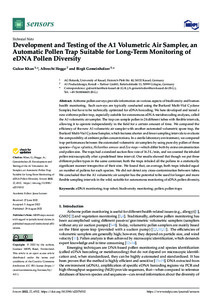| dc.date.accessioned | 2023-01-04T10:30:09Z | |
| dc.date.available | 2023-01-04T10:30:09Z | |
| dc.date.issued | 2022-08-29 | |
| dc.identifier | doi:10.17170/kobra-202301037288 | |
| dc.identifier.uri | http://hdl.handle.net/123456789/14327 | |
| dc.description.sponsorship | Gefördert durch den Publikationsfonds der Universität Kassel | ger |
| dc.language.iso | eng | eng |
| dc.rights | Namensnennung 4.0 International | * |
| dc.rights.uri | http://creativecommons.org/licenses/by/4.0/ | * |
| dc.subject | eDNA monitoring | eng |
| dc.subject | trap robot | eng |
| dc.subject | biodiversity monitoring | eng |
| dc.subject | pollen | eng |
| dc.subject | pollen traps | eng |
| dc.subject.ddc | 570 | |
| dc.subject.ddc | 600 | |
| dc.title | Development and Testing of the A1 Volumetric Air Sampler, an Automatic Pollen Trap Suitable for Long-Term Monitoring of eDNA Pollen Diversity | eng |
| dc.type | Aufsatz | |
| dcterms.abstract | Airborne pollen surveys provide information on various aspects of biodiversity and human health monitoring. Such surveys are typically conducted using the Burkard Multi-Vial Cyclone Sampler, but have to be technically optimized for eDNA barcoding. We here developed and tested a new airborne pollen trap, especially suitable for autonomous eDNA-metabarcoding analyses, called the A1 volumetric air sampler. The trap can sample pollen in 24 different tubes with flexible intervals, allowing it to operate independently in the field for a certain amount of time. We compared the efficiency of the new A1 volumetric air sampler with another automated volumetric spore trap, the Burkard Multi-Vial Cyclone Sampler, which features shorter and fewer sampling intervals to evaluate the comparability of ambient pollen concentrations. In a sterile laboratory environment, we compared trap performances between the automated volumetric air samplers by using pure dry pollen of three species—Fagus sylvatica, Helianthus annuus and Zea mays—which differ both by exine ornamentation and pollen size. The traps had a standard suction flow rate of 16.5 L/min, and we counted the inhaled pollen microscopically after a predefined time interval. Our results showed that though we put three different pollen types in the same container, both the traps inhaled all the pollens in a statistically significant manner irrespective of their size. We found that, on average, both traps inhaled equal an number of pollens for each species. We did not detect any cross-contamination between tubes. We concluded that the A1 volumetric air sampler has the potential to be used for longer and more flexible sampling intervals in the wild, suitable for autonomous monitoring of eDNA pollen diversity. | eng |
| dcterms.accessRights | open access | |
| dcterms.creator | Khan, Gulzar | |
| dcterms.creator | Hegge, Albrecht | |
| dcterms.creator | Gemeinholzer, Birgit | |
| dc.relation.doi | doi:10.3390/s22176512 | |
| dc.subject.swd | Umwelt | ger |
| dc.subject.swd | DNS | ger |
| dc.subject.swd | Biomonitoring | ger |
| dc.subject.swd | Biodiversität | ger |
| dc.subject.swd | Pollen | ger |
| dc.subject.swd | Falle | ger |
| dc.type.version | publishedVersion | |
| dcterms.source.identifier | eissn:1424-8220 | |
| dcterms.source.issue | Issue 17 | |
| dcterms.source.journal | Sensors | eng |
| dcterms.source.volume | Volume 22 | |
| kup.iskup | false | |
| dcterms.source.articlenumber | 6512 | |


